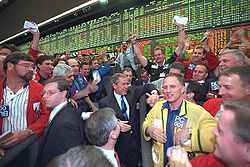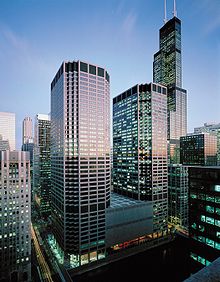- Chicago Mercantile Exchange
-
Chicago Mercantile Exchange Type Subsidiary Industry Business Services Founded 1898 Headquarters Chicago, Illinois Key people Terrence A. Duffy, Chairman
Craig S. Donohue, CEO
Phupinder Gill, President & COO
Leo Melamed, Chairman EmeritusProducts Futures & Options on futures Revenue $3.003 billion USD (CME Group 2010 GAAP) Owner(s) CME Group Website www.cmegroup.com The Chicago Mercantile Exchange (CME) (often called "the Chicago Merc," or "the Merc") is an American financial and commodity derivative exchange based in Chicago. The CME was founded in 1898 as the Chicago Butter and Egg Board. Originally, the exchange was a non-profit organization. The exchange demutualized in November 2000, went public in December 2002, and it merged with the Chicago Board of Trade in July 2007 to become a designated contract market of the CME Group Inc. The Chief Executive Officer of CME Group is Craig S. Donohue.[1][2] On August 18, 2008 shareholders approved a merger with the New York Mercantile Exchange (NYMEX) and COMEX. The Merc, CBOT, NYMEX and COMEX are now markets owned by the CME Group.
CME trades several types of financial instruments: interest rates, equities, currencies, and commodities. It also offers trading in alternative investments such as weather and real estate derivatives, and has the largest options and futures contracts open interest (number of contracts outstanding) of any futures exchange in the world.
CME also pioneered the CME SPAN software, used around the world as the official performance bond (margin) mechanism of 50 registered exchanges, clearing organizations, service bureaus and regulatory agencies throughout the world.
On October 7, 2008, the Chicago Mercantile Exchange (CME) Group announced that it will be teaming up with Citadel LLC to create a transparent electronic trading platform for credit default swaps.[3] The joint venture between CME and Citadel will operate as an independent organization with its own board of directors and management team.[4] The new venture plans to initially provide clearing services for contracts involving credit-default swap indices, which typically have more standardized terms than swap contracts for individual bonds. It is expected to eventually expand its offering to include other derivative indices as well as the multitude of single-name corporate derivatives.[5][6] Major market participants will be invited to join the platform as founding members, in return for receiving a 30% equity portion of the venture.[3]
Contents
Trading platforms
Trading is conducted in two methods; an open outcry format and the CME Globex electronic trading platform. Approximately 80 percent of total volume at the exchange occurs electronically on CME Globex.
Open Outcry
Operating during regular trading hours (RTH), the open outcry method consists of floor traders standing in a trading pit to call out orders, prices, and quantities of a particular commodity. Different colored jackets are worn by the traders to indicate their function on the floor (traders, runners, CME employees, etc.). In addition, complex hand signals (called Arb) are used. These hand signals were first used in the 1970s. The pits are areas of the floor that are lowered to facilitate communication, sort of like a miniature amphitheater. The pits can be raised and lowered depending on trading volume. To an onlooker, the open outcry system can look chaotic and confusing, but in reality the system is a tried and true method of accurate and efficient trading. An illustrated project to record the hand signal language used in CME's trading pits has been compiled[7].
 Former President George W. Bush at the CME (March 6, 2001).
Former President George W. Bush at the CME (March 6, 2001).
Electronic trading
Operating virtually around the clock, today the CME Globex trading system is at the heart of CME. Proposed in 1987, it was introduced in 1992 as the first global electronic trading platform for futures contracts. This fully electronic trading system allows market participants to trade from booths at the exchange or while sitting in a home or office thousands of miles away. On 19 October 2004, the one billionth (1,000,000,000) transaction was recorded.
When Globex was first launched, it used Reuters' technology and network. September 1998 saw the launch of the second generation of Globex using a modified version of the NSC trading system, developed by Paris Bourse for the MATIF (now Euronext).
To connect to Globex, traders connect via Market Data Protocol (MDP) and iLink 2.0 for order routing.
Mergers and Acquisitions
In 2006, CME purchased "Swapstream", an interest rate swaps electronic trading platform, based in London.
On October 17, 2006, the Chicago Mercantile Exchange announced the purchase of the Chicago Board of Trade for $8 billion in stock, rejoining the two financial institutions as CME Group, Inc. CBOT formerly used outsourced technology platforms, but has moved over to CME's Globex trading system. This will provide much of the merger's anticipated savings. The merger will also strengthen the combined group's position in the global derivatives market.[8] The merger agreement was modified on December 20, 2006,[9] May 11, 2007,[10] June 14, 2007,[11] and on July 6, 2007.[12] The merger agreement was passed by shareholders of both CME and the Chicago Board of Trade on July 9, 2007.[13] The merger officially closed on July 12, 2007, after which the Chicago Board of Trade shares (old symbol: BOT) stopped trading and were converted into CME shares as agreed, and the overarching holding company began life as CME Group, a CME/Chicago Board of Trade Company.[14] On January 13, 2008 electronic trading at the Chicago Board of Trade shifted onto the Mercantile Exchange's computer system.[15]
On March 17, 2008, the New York Mercantile Exchange (NYMEX) accepted an offer from CME Group, the parent of the Chicago Mercantile Exchange, to purchase NYMEX for $8.9 billion in cash and CME Group Stock.[16] The acquisition was formally completed on August 22, 2008, and the NYMEX systems were fully integrated by September 30, 2009.[17]
Commodity futures and options
Agricultural Commodity Contracts include: Live Cattle, Lean Hogs,Feeder Cattle, Class IV Milk, Class III Milk, Frozen Pork Bellies, International Skimmed Milk Powder (ISM), Nonfat Dry Milk, Deliverable Nonfat Dry Milk, Dry Whey, Cash-Settled Butter, Butter, Random Length Lumber, Softwood Pulp, Hardwood Pulp.
See also
- CME Group
- Demutualization
- List of futures exchanges
- List of traded commodities
- Commodity Exchange Act
- Chicago Board of Trade
References
- Durica, Dr. Michael (2006). Product Development for Electronic Derivative Exchanges: The case of the German ifo business climate index as underlying for exchange traded derivatives to hedge business cycle risk. Pro Business. Berlin. ISBN 10: 3-939533-05-X.
Notes
- ^ CMEgroup.com
- ^ CMEgroup.com
- ^ a b CNN.com
- ^ "CME Group and Citadel to Launch the First Integrated Credit Default Swaps Trading Platform and Central Counterparty Facility, Linked to CME Clearing". December 28, 2008. http://cmegroup.mediaroom.com/index.php?s=43&item=2730&pagetemplate=article.
- ^ Efinancialnews.com
- ^ Hedgefundsreview.com
- ^ "CME Trading Pit Hand Signals History". http://tradingpithistory.com/gallery/2/prices_quantities/cme/. http://tradingpithistory.com/gallery/2/prices_quantities/cme/. Retrieved 16 August 2011.
- ^ "CME news release October 17, 2006". http://cme.mediaroom.com/index.php?s=press_releases&item=218.
- ^ "Merger agreement modified December 20, 2006.". http://cme.mediaroom.com/index.php?s=press_releases&item=250.
- ^ "Merger agreement modified May 11, 2007.". http://cme.mediaroom.com/index.php?s=press_releases&item=312.
- ^ "Merger agreement modified June 14, 2007.". http://cmegroup.mediaroom.com/index.php?s=43&item=329.
- ^ "Merger agreement modified July 6, 2007.". http://cme.mediaroom.com/index.php?s=press_releases&item=350.
- ^ "Merger agreement passed July 9, 2007.". http://cme.mediaroom.com/index.php?s=press_releases&item=353.
- ^ "CME Group begins operations July 13, 2007.". http://cmegroup.mediaroom.com/index.php?s=43&item=591.
- ^ Saphir, Ann (2008-03-03). "Trading Places". Crain's Chicago Business (Crain Communications Inc.).
- ^ CMEgroup.com
- ^ CMEgroup.com
External links
Categories:- 1898 establishments
- Commodity exchanges in the United States
- Self-regulatory organizations
- Companies based in Chicago, Illinois
- Futures exchanges
- Economy of Chicago, Illinois
Wikimedia Foundation. 2010.

